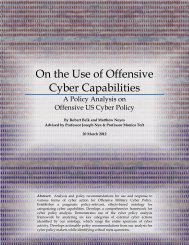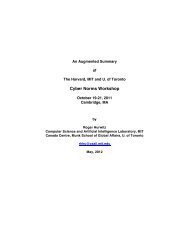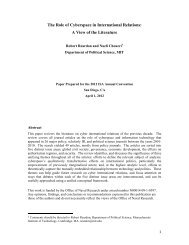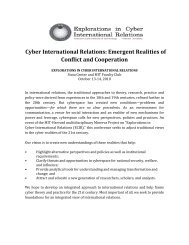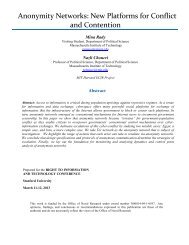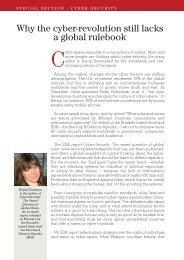Stewardship of Cyberspace: Duties for Internet Service Providers
Stewardship of Cyberspace: Duties for Internet Service Providers
Stewardship of Cyberspace: Duties for Internet Service Providers
Create successful ePaper yourself
Turn your PDF publications into a flip-book with our unique Google optimized e-Paper software.
HATHAWAY/SAVAGE: <strong>Stewardship</strong> <strong>of</strong> <strong>Cyberspace</strong>: <strong>Duties</strong> <strong>for</strong> <strong>Internet</strong> <strong>Service</strong> <strong>Providers</strong> 3<br />
The latter duties are helpful in calibrating<br />
threats and funding responses to them.<br />
The <strong>Internet</strong> is radically different from the plain<br />
old telephone service (POTS) that has provided<br />
voice communication since the nineteenth cen-<br />
tury. POTS established a “circuit” or path through<br />
the telephone network that remained constant<br />
during the communication session. The telephone<br />
network operated according to a strict, regi-<br />
mented set <strong>of</strong> processes and technologies that<br />
provided a highly reliable service, but adapted to<br />
change slowly. It did not have an application pro-<br />
gramming interface (API) to allow <strong>for</strong> third-party<br />
access and experimenting with telecommunica-<br />
tion services was discouraged.<br />
The <strong>Internet</strong> operates much differently. Long<br />
messages are decomposed into packets that<br />
move from source to destination following<br />
potentially different paths through the network.<br />
This is called packet switching. The <strong>Internet</strong> also<br />
provides a simple interface to communication<br />
networks that makes it easier <strong>for</strong> third par-<br />
ties to create innovative communication-based<br />
products to connect and access the <strong>Internet</strong><br />
and providers to introduce a new generation <strong>of</strong><br />
value-added services and applications. Yet, the<br />
<strong>Internet</strong> and the communications and services<br />
that ride on it rely on the integrity <strong>of</strong> routing<br />
and naming infrastructures. These two critical<br />
functions are essential to the proper functioning<br />
<strong>of</strong> the <strong>Internet</strong>.<br />
ROUTING<br />
The <strong>Internet</strong> is a network <strong>of</strong> networks. Networks<br />
consist <strong>of</strong> end systems, called hosts, and interme-<br />
diate systems, called routers, connected via com-<br />
munication channels. In<strong>for</strong>mation travels through<br />
a network on paths chosen by a routing process<br />
that is implemented by routers. These paths<br />
automatically change many times a day, as con-<br />
gestion on one network might make an alternate<br />
path more attractive, or if a network has down-<br />
time – either intentional or not – so a new path is<br />
needed until the preferred path is restored.<br />
Un<strong>for</strong>tunately, the technology in use today to<br />
ensure the <strong>Internet</strong> is operational is based on<br />
trust; it cannot give adequate guarantees that<br />
the expected network configuration is the one<br />
in place. As a consequence, one ISP can issue<br />
an update to another, whether by accident or<br />
by design, that will send <strong>Internet</strong> traffic to the<br />
wrong destinations. This lack <strong>of</strong> trust has resulted<br />
in major disruptions <strong>of</strong> <strong>Internet</strong> routing and can<br />
enable malicious activity, such as monitoring traf-<br />
fic, identity theft, and disruption <strong>of</strong> commerce.<br />
NAMING<br />
ISPs provide naming services to both their<br />
customers and other <strong>Internet</strong> users. Domain<br />
names are human-friendly names that are trans-<br />
lated into <strong>Internet</strong> Protocol (IP) addresses, <strong>for</strong><br />
example www.acme.com is a domain name,<br />
and 216.27.178.28 is its IP address. People like<br />
to use domain names and routers like to use IP<br />
addresses. There<strong>for</strong>e, a system that converts<br />
one to the other was needed: the Domain Name<br />
System (DNS).<br />
The DNS is the “telephone directory” that does<br />
this translation <strong>for</strong> the <strong>Internet</strong>. This “telephone<br />
directory” is implemented as a hierarchical<br />
collection <strong>of</strong> “servers.” The DNS system was<br />
not designed to be inherently secure. When a<br />
request comes in to translate, a series <strong>of</strong> que-<br />
ries and responses occur until a mapping is<br />
found <strong>for</strong> the domain name in question. When<br />
a request is made, the requestor accepts the<br />
first response that it receives, and then uses it.<br />
Imagine asking a question to a room <strong>of</strong> strangers,



